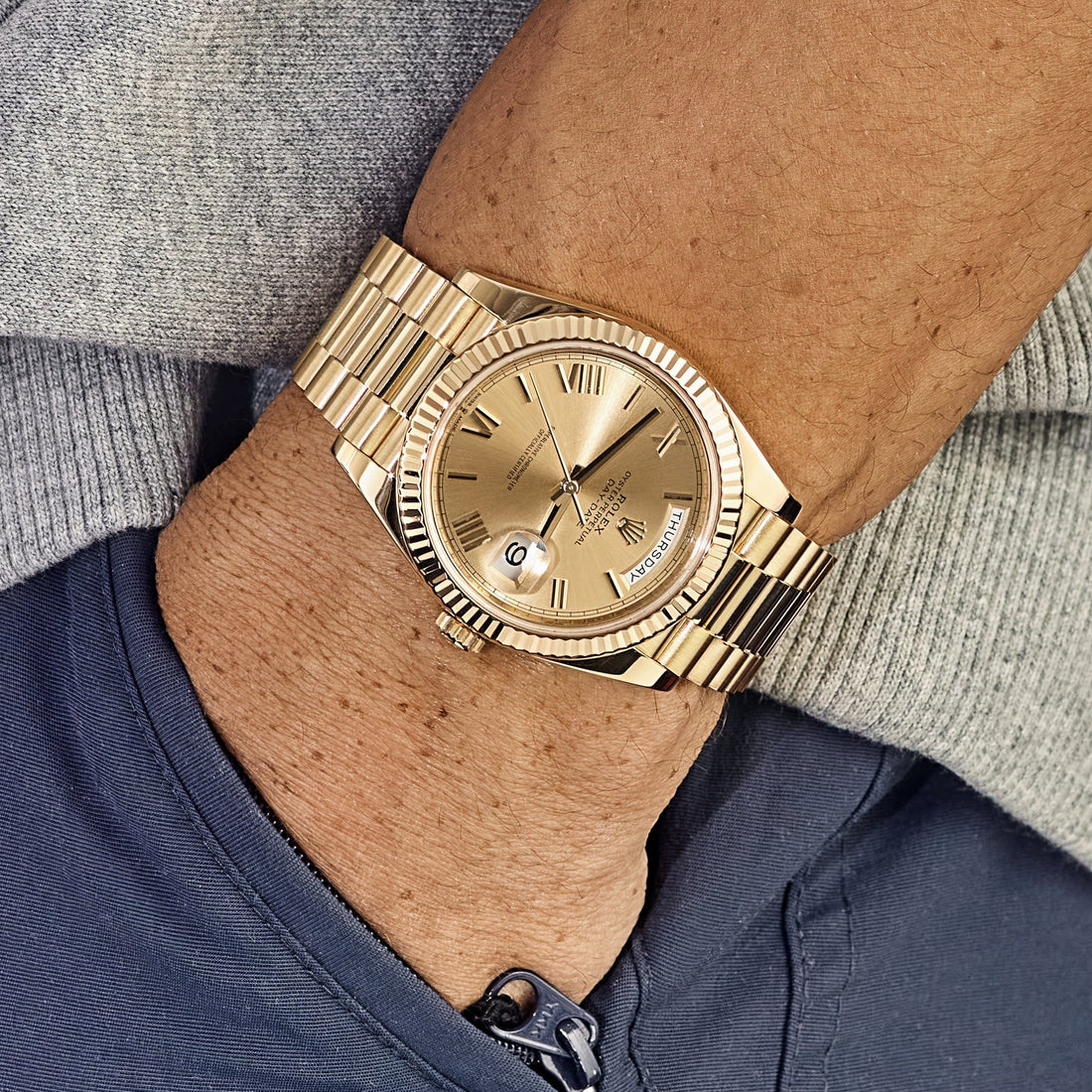
How To Clean A Gold Watch Without Screwing It Up
Share
Owning a gold watch is a flex. Keeping it clean is a responsibility. Not scratching it whilst doing so is a challenge.
Whether it’s a vintage Rolex Day-Date picked up from a Geneva auction or a modern Omega Speedmaster Moonshine Gold straight off the shelf in New York, gold watches need proper care.
Not just because they’re expensive, but because they’re soft. Gold scratches A LOT more easily than steel and can quickly lose its lustre without the right maintenance.
Understand Your Gold
Not all gold is the same. Most watches are gold alloyed with other metals to add strength and change the colour.
Yellow gold is the classic option found in pieces like the Patek Philippe Calatrava Ref. 5119J or the early Rolex Day-Date 1803. It has a warm, rich tone and is often softer than other alloys.
White gold uses rhodium plating to give it a cooler, silver-like appearance. Vacheron Constantin’s Patrimony or the Lange 1 Moon Phase in white gold are strong examples. This plating can wear off with time, so cleaning must be gentle.
Rose gold blends gold with copper and silver for a more reddish tone. Each brand has its own formula: Rolex uses Everose, Omega calls it Sedna, and Hublot markets King Gold. These are found in watches like the Audemars Piguet Royal Oak Chronograph or the Cartier Santos-Dumont XL.
Red gold contains a higher percentage of copper, giving it a deeper colour. F.P. Journe often uses red gold in pieces like the Chronomètre Souverain.
Different alloys react differently to moisture, oils and cleaning agents. Knowing the material helps reduce the risk of damage.
Know Your Bracelet Or Strap
Cleaning a solid gold bracelet isn’t the same as caring for a leather or rubber strap.
The President bracelet on a Rolex Day-Date has semi-circular links that trap grime around the crown clasp. The Royal Oak bracelet, with its brushed finish and sharp bevels, is difficult to clean without the right tools. Gold Milanese mesh or multi-link bracelets from brands like Chopard can collect dirt deep in the weave.
Leather or rubber straps should never be submerged in water. Even minimal moisture can damage stitching, adhesives or cause the strap to deteriorate.
A Step-By-Step Cleaning Guide
Use the right kit
Start with a soft-bristle brush, a microfibre cloth, and a watch-safe cleaning solution such as the Heist Watch & Jewellery Cleaner. This Australian-made formula is all-natural and won’t corrode finishes or strip protective coatings.
Avoid submerging the watch.
Even if the case is rated for water resistance, avoid dunking it in water unless it has been recently pressure-tested. Use a lightly dampened cloth with warm water and mild soap to wipe down the surface.
Clean with care
Dip the soft brush in the cleaning solution and gently work it around the lugs, crown, bezel, and bracelet links. Focus on areas where grime builds up over time. Use light circular motions and avoid applying too much pressure.
Rinse gently and dry
Wipe off any remaining residue with a clean damp cloth. Pat it dry using a soft microfibre cloth, then let the watch air dry completely before storing or wearing it again.
Avoid polishing compounds
Skip metal polishes and abrasive compounds. These can damage gold plating or permanently alter the finish. If the watch has scratches or needs a shine, have it professionally polished by a watchmaker. Keep in mind that every polish removes material, so it's best done sparingly.
A Watch Worth Maintaining
A clean gold watch wears better, looks better and holds its value longer. Regular maintenance is part of ownership whether it’s a gold Bulgari Octo Finissimo Skeleton, a Piaget Altiplano in white gold, or something louder like a Jacob & Co. Astronomia in red gold.
Wipe it down every few weeks. Avoid contact with sunscreen, sweat, and salt water. Keep it stored away from hard objects and extreme heat.
And always use a proper cleaner, not your shirt cuff.



